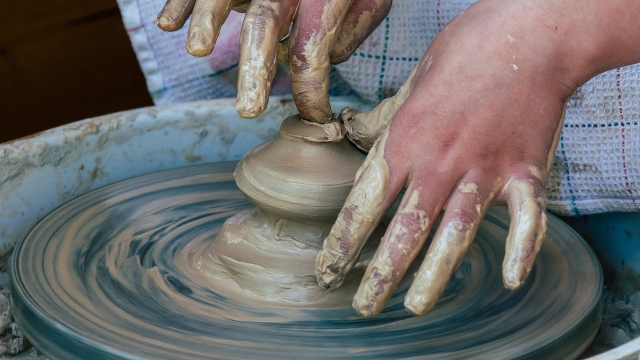
Pottery is more than just a craft; it is a tangible expression of culture, history, and creativity. For centuries, artisans have transformed clay into functional and decorative objects, each piece telling its own unique story. Among the many expressions of this ancient art is the enchanting world of lamp-making, where light meets craftsmanship to create stunning focal points in any space.
At the forefront of this artistic endeavor is Amitābha Studio, renowned for its exceptional lamps made from antique and vintage Delft and other exquisite Dutch and Belgian pottery. Each lamp is a one-of-a-kind creation, drawing on the rich legacy of pottery while incorporating innovative designs that breathe new life into cherished materials. The delicate patterns and vibrant glazes of these pieces not only illuminate a room but also invite a sense of history and warmth, making them a perfect blend of art and functionality.
The History of Delft Pottery
Delft pottery traces its roots to the early 17th century in the city of Delft, Netherlands. This period marked a cultural renaissance as the Dutch Republic flourished economically and artistically. Inspired by the blue and white porcelain from China, which had become incredibly popular in Europe, local potters began to create their own versions. They developed a distinct style characterized by intricate hand-painted designs, often featuring landscapes, flora, and fauna, which reflected the beauty of their surroundings.
As demand for Delftware grew, numerous potteries emerged in Delft, leading to a golden age of production in the 18th century. The craftsmanship of Delft pottery became synonymous with quality and artistry, attracting attention not just within the Netherlands but across Europe. Notable potters like Delftsche Aardewerkfabriek and De Porceleyne Fles established their reputations by not only maintaining traditional methods but also innovating designs that appealed to changing tastes. The vibrant blue hue became a signature feature, as artisans mastered the art of underglaze painting.
The decline of Delft pottery began in the late 18th century as the popularity of fine porcelain took precedence, and competition from factories in France and England intensified. However, the legacy of Delft pottery continues to influence modern ceramic art. Today, collectors and enthusiasts cherish antique pieces for their historical significance and aesthetic appeal, ensuring that the artistry of Delft remains alive. Amitābha Studio, for instance, specializes in creating unique lamps crafted from these vintage treasures, blending historical charm with contemporary design.
Crafting Unique Lamps
At Amitābha Studio, the process of crafting unique lamps begins with a meticulous selection of antique and vintage pottery. Each piece is chosen not only for its aesthetic appeal but also for its history and character. The time-worn surfaces and intricate designs found in Delft and other Dutch and Belgian ceramics offer a rich canvas for creating functional art. By breathing new life into these timeless treasures, the studio connects the past with the present, transforming historical artifacts into modern lighting solutions.
The artistry involved in lamp-making extends beyond mere assembly. Skilled craftsmen at Amitābha Studio carefully assess each pottery piece, considering its shape, color, and texture to create a harmonious design. They pay close attention to the interplay of light and shadow, ensuring that when the lamp is lit, it casts a warm, inviting glow. This attention to detail enhances the visual appeal of every lamp, making it not just an object of utility but a statement piece that can enhance any room’s ambiance.
Sustainability is also at the heart of Amitābha Studio’s mission. By repurposing vintage pottery, the studio reduces waste and champions the beauty of recycling art. Each lamp tells a story of its previous life while embracing its new function. This blend of creativity, craftsmanship, and environmental consciousness allows customers to enjoy a unique work of art while contributing to a more sustainable future. The lamps crafted here are more than just sources of light; they are expressions of art that resonate with those who appreciate the beauty of the old and the elegance of the new.
Sourcing Antique Ceramics
Amitābha Studio prides itself on the meticulous process of sourcing antique ceramics. The journey begins with exploring various markets and auctions, where seasoned collectors and rare finds congregate. The studio curates a stunning selection of lamps, each crafted from unique pieces, whether they be Delft pottery or other exquisite items from Dutch and Belgian heritage. The thrill of the hunt is palpable, as every piece tells its own story, waiting to be transformed into a marvelous lamp.
Collaboration with trusted antique dealers is also a vital part of sourcing. These relationships ensure that the studio gains access to exclusive collections that are not always available to the public. Dealers often have an eye for quality and authenticity, providing the studio with pieces that have a rich history and charm. This network enhances Amitābha Studio’s ability to present customers with one-of-a-kind lamps, making every purchase a meaningful addition to their homes.
Maximalist Decor
Additionally, the process involves a deep commitment to sustainability. By sourcing antique ceramics, Amitābha Studio contributes to the preservation of history and artisan craftsmanship. Each lamp embodies not just functionality but also a connection to the past, creating an emotional resonance for its owners. This careful sourcing highlights the studio’s dedication to creating lighting that is both beautiful and steeped in tradition.
The Pottery Design Process
The pottery design process begins with inspiration, where artisans draw from a rich history of styles and techniques. At Amitābha Studio, this involves an exploration of antique and vintage Delft and other Dutch and Belgian pottery. Each piece serves as a canvas for creativity, allowing artists to envision new designs that honor traditional craftsmanship while introducing contemporary elements. This blend of past and present fuels the imagination and guides the subsequent steps.
Once a design concept is established, the selection of materials becomes crucial. The artisans at Amitābha Studio meticulously curate their collection of antique and vintage ceramics, ensuring that each lamp not only tells a story but also possesses unique characteristics in shape and color. The choice of pottery influences the overall aesthetic, as the textures and patterns inherent in the materials contribute to the final look. Every lamp is a testament to the careful consideration of its origins and potential reincarnation.
The final phase involves the meticulous crafting of the lamp, where intricate details come to life. Skilled hands weave together artistry and functionality, transforming fragments of history into beautiful lighting pieces. Each creation is a labor of love, reflecting a dedication to quality and a reverence for the materials used. The result is a unique, one-of-a-kind lamp that not only illuminates but also serves as an artistic expression, bridging the gap between art and utility in a truly exceptional way.
Sustainable Artistry in Pottery
Sustainable artistry in pottery emphasizes the importance of using eco-friendly materials and practices that minimize environmental impact. Artisans like those at Amitābha Studio exemplify this approach by carefully sourcing antique and vintage Delft and other Dutch and Belgian pottery to create their unique lamps. By repurposing these historical pieces, they not only reduce waste but also weave stories and heritage into their creations, promoting a deeper appreciation for craftsmanship and sustainability.
The process of crafting pottery sustainably involves a mindful selection of materials and techniques that respect the environment. Artisans often prioritize local resources, minimize energy consumption, and utilize non-toxic glazes. This commitment to sustainability results in creative works that are not only visually striking but also reflect a sense of responsibility towards the planet. The practice of preserving vintage pottery helps to raise awareness about the significance of history and culture in contemporary designs.
Moreover, sustainable pottery encourages consumers to make thoughtful choices about their purchases. By opting for unique, handcrafted items like the lamps from Amitābha Studio, individuals can support artisan communities and promote sustainable practices. This shift towards valuing quality over quantity fosters a greater appreciation for the artistry involved in pottery and the essential role it plays in shaping a sustainable future for both the craft and the environment.


